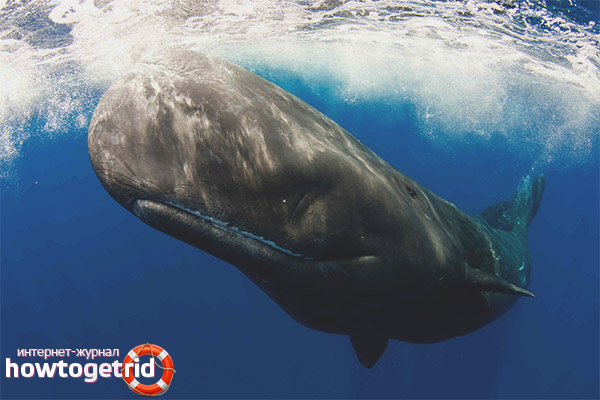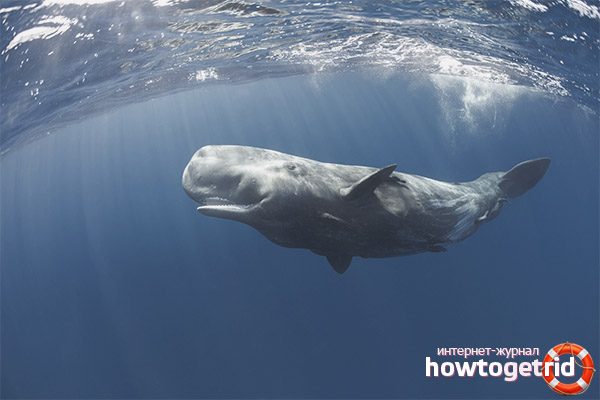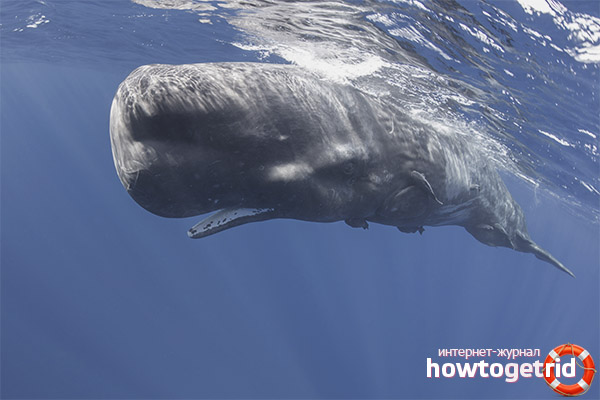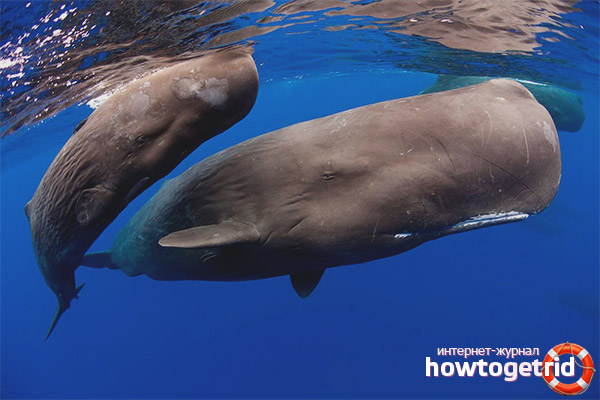The content of the article
Sperm whale - a mammal from the order of cetaceans, belongs to the largest animals of our planet. The length of a male individual can range from 18 to 20 meters, and weight can reach 50 tons. Females can be up to 13 meters in length and weighing up to 20 tons. Males and females have a number of distinctive features. They have different head shapes and number of teeth, physique and, in fact, body size.
Appearance
The appearance of a sperm whale can be fearful. Particularly impressive is the head, which in profile is a rectangle, because it accounts for a third of the entire length of an adult animal. The main feature in the structure of the head of a mammal is that it has a spermaceti bag of high-strength fibrous tissue, which accounts for almost 90% of the total weight of the head. The spermaceti filling the bag has a waxy consistency and, from a chemical point of view, is animal fat. Previously, this substance was used in the manufacture of candles, lipsticks and various ointments. The bag plays the role of an acoustic lens that focuses the sound and helps the animal find prey. Also, when the sperm whale dives to a depth or rises to the surface, the bag is designed to provide him with the required level of buoyancy.
In the lower part of the head of a mammal in a special notch is its mouth. The narrow and long lower jaw has 20-26 tooth pairs. The shape of all teeth is the same - a cone. Each weight is about a kilogram. At the same time, there is only one or a maximum of three pairs of teeth on the upper jaw.
Sperm whale eyes are located at the corners of the mouth and are large enough (the eyeball can be up to 17 cm in diameter), which distinguishes them from other representatives of their squad. In the middle of its body, the whale is actually of circular cross section, gradually tapering closer to the tail. On the back of the mammal there is a fin, small in proportion to the whole body, and having the shape of a hump. Behind it are smaller humps, usually no more than two. The caudal fin, which can be seen when the sperm whale dives, reaches 5 meters wide. On the lower surface of the caudal peduncle, a longitudinal keel is distinguished. The body of the animal is also equipped with pectoral fins. They are short (up to 1.8 m) and others wide (about 90 cm).
The skin of the animal is wrinkled, when you look at it it is striking that the whole sperm whale, except for the head, is covered with folds. Usually the color of the skin is gray, dark shades, which are often mixed with other tones, such as blue and blue, brown or brown. Still animals are almost black in color, but white individuals are very rare.
Lifestyle features
Sperm whales actively communicate with each other using sounds. The voice signals that they give each other are quite common for all whales. These are creaks, groans, as well as loud clicks that can turn into a quick fractional crack, similar to the one published by a typewriter.Sperm whales are superior in strength to their voice to all animals on the planet, their sounds can reach an absolute volume level of 115 decibels, which is comparable to the volume of aircraft engines. And the roar of this mammal, stuck on the shallows, can not be compared at all.
Habitat

Sperm whale boasts the widest habitat on our planet, which covers the vast majority of the oceans. However, these mammals prefer warm waters and do not go beyond the 60th parallel either in the north or in the south. The favorite depth of sperm whales is 200 meters or more. However, possessing a body consisting to a large extent of fat, individual individuals can fall under the water and up to 3 thousand meters without suffering from excessive pressure. Their commitment to the depths is explained by the fact that there live large cephalopods, which form the basis of the diet of giant whales. The seasonal migrations of giant mammals are also due to this. Following their food, they spend winters at the equator, and in the summer season they are drawn closer to the poles of the Earth. In the southern hemisphere, large masses of sperm whales can be observed off the coast of Chile, Peru and the South African coast of the Indian Ocean.
In the Atlantic Ocean, traveling in the warm waters of the Gulf Stream, they can rise to higher latitudes. In general, with regard to the Northern Hemisphere, sperm whales can be found in the seas of East Asia, near Africa and the Azores. In males, the migration zone is somewhat wider than in females, who prefer not to leave the water with a temperature of 15-17 degrees. It is also characteristic that, geographically, herds of sperm whales, even when migrating, adhere to their ranges without violating the boundaries of the habitats of other groups of their relatives.
Sperm whales can reach speeds of up to 37 km / h. But, when they feed (i.e. most of the time), the speed of their movement drops sharply - up to 10 km / h, even during migrations. These indicators are noticeably lower than that of other representatives of this mammalian order. However, animals in an excited state are able to fully jump out of the water, then collapsing down with a loud splash. They can freeze for a long time in an upright position, sticking out part of the head above the water. And during sleep, by the way, the shortest in the animal world - about 7% of the total time, sperm whales in a daze freeze at the surface of the water.
Regarding the life expectancy of sperm whales, scientists have not yet reached a consensus. Different researchers give them different periods of life - from 40 to 60 years. In one case, an individual was registered at the age of 77 years.
Nutrition
Like all other toothed whales, sperm whales are predators. In their diet, cephalopods occupy 95%. The rest of the diet of giants is mainly fish, and for males it is of greater importance than for females. Of the variety of cephalopods, preference is given to squid and, in very small quantities, to octopuses.
The bulk of the sperm whale food is located at a depth of 500 meters, where they do not have to fear food competitors. To maintain their life processes an adult requires up to 1 thousand kg of food daily.
Sperm whales do not chew food, but are swallowed entirely by piston-like movements of the tongue. They can break large production into several pieces. It is interesting that large squids and octopuses can remain alive inside the sperm whale for some time: this is evidenced by the traces of their suction cups, which were researchers on the inner surface of the stomachs of these whales. A special dish in the diet of sperm whales are giant deep-sea squids; for these cephalopods, the sperm whale is the only natural enemy, because squids grow up to 10 meters or more in length.
Many cases have been described when all kinds of plastic objects, parts of ships, toys, skeins of wire and other rubbish like rubber boots, dishes and so on were found in the stomachs of sperm whales. Interestingly, these whales also swallow stones, with the help of which, perhaps, they grind the swallowed food, like millstones.
Propagation method
Male sperm whales are considered sexually mature when they reach the age of 5 years and grow to 9.5-10 meters. Females reach maturity earlier - at 4-5 years, with a body length of about 9 meters and retain the ability to reproduce up to 40 years. The reproductive cycle of these whales is approximately 3 years. But all these data may differ in different herds of sperm whales, depending on their geographical location.
Sperm whales are polygamous, males collect harems for themselves, in which there can be up to 15 females. During mating, males show extreme aggression, fights occur between them, during which severe injuries and injuries can occur.
The period of gestation lasts 15-18 months or more, after which the female brings one (very rarely two) cubs up to 4 meters long and weighing up to 1 thousand kg. A newborn is immediately able to follow his mother. According to various sources, the period of milk feeding lasts from 6 months to a year.
What is the difference between sperm whales and whales?
There are a number of differences between sperm whales and other whales:
- The difference in body structure.
- The presence and number of teeth.
- The difference in weight and size of females and males.
- Significant differences in diet.
- Different speed of movement.
- The difference in immersion depth.
- Finally, the sperm whale is theoretically able to completely swallow a person, a whale - no.
People and sperm whales
As for the behavior of sperm whales when meeting a person, in a normal environment they do not show aggressiveness and do not consider a person as part of a diet. These giants can pose a real threat during the mating period or when hunting for them - in these cases they should not destroy a small vessel.
But divers and lovers of swimming in the open sea should remember that the sperm whale, sucking a huge mass of water during meals, can accidentally suck a swimmer without even feeling it.
Video: sperm whale (Physeter macrocephalus)












Submit